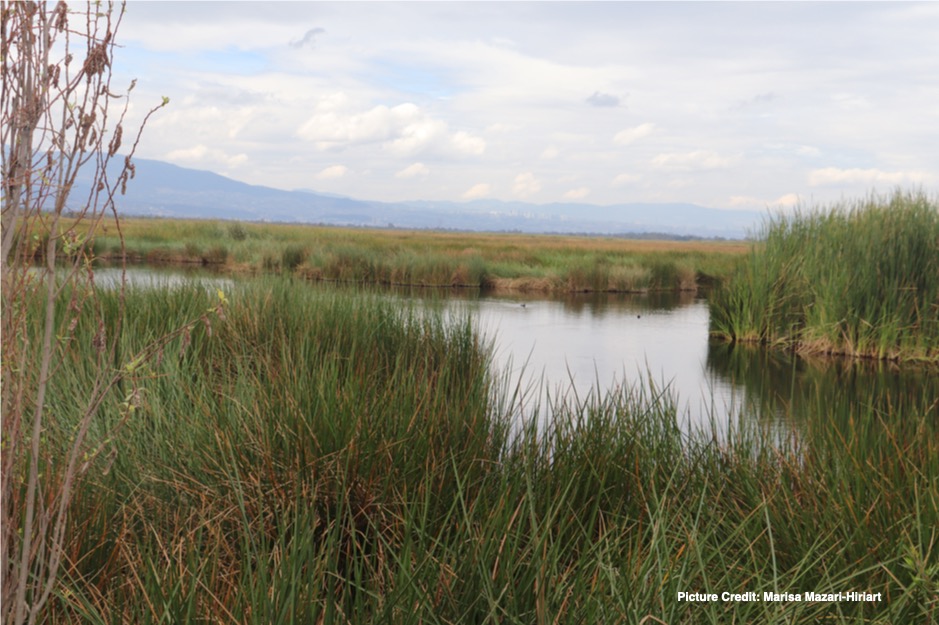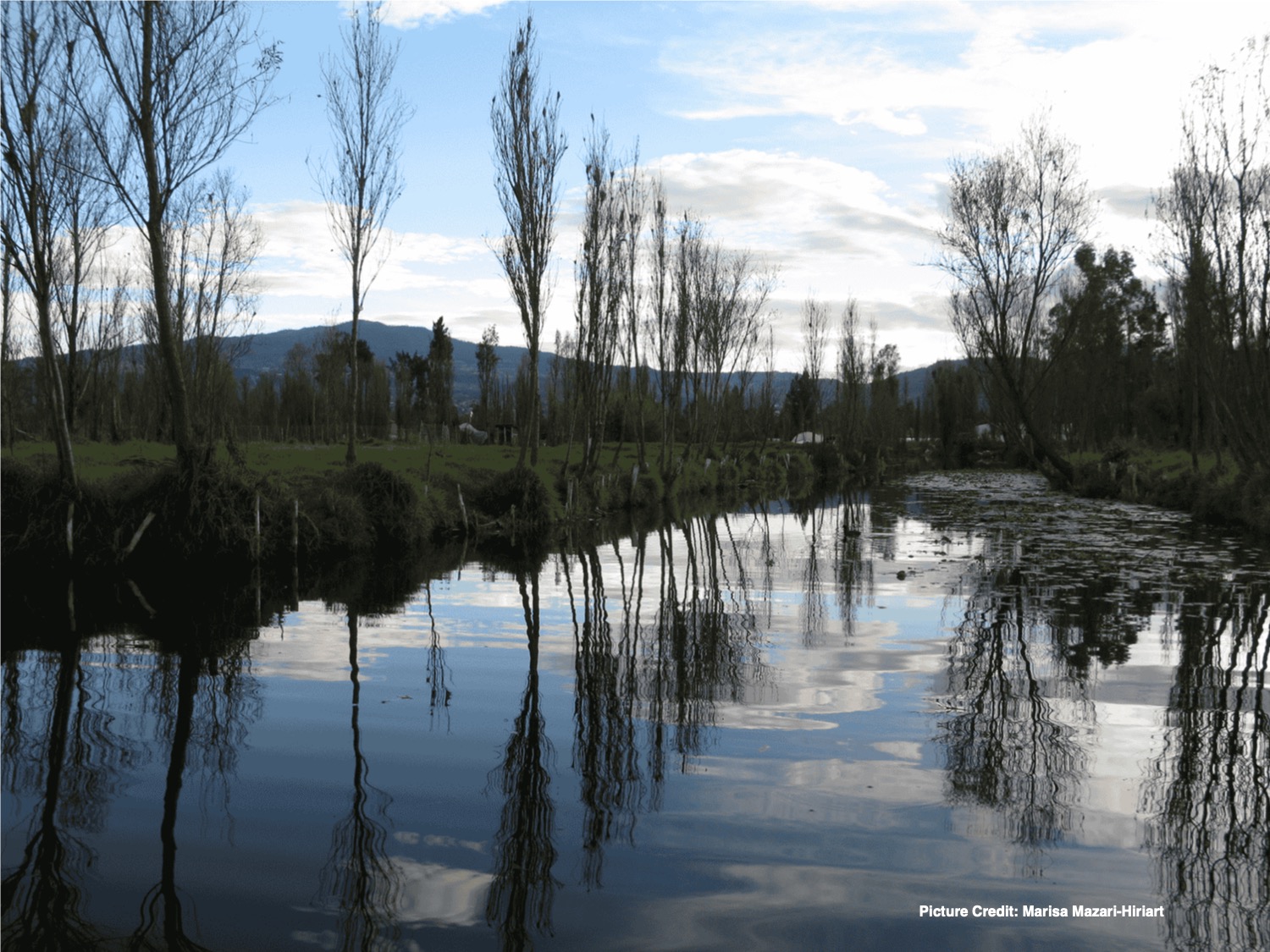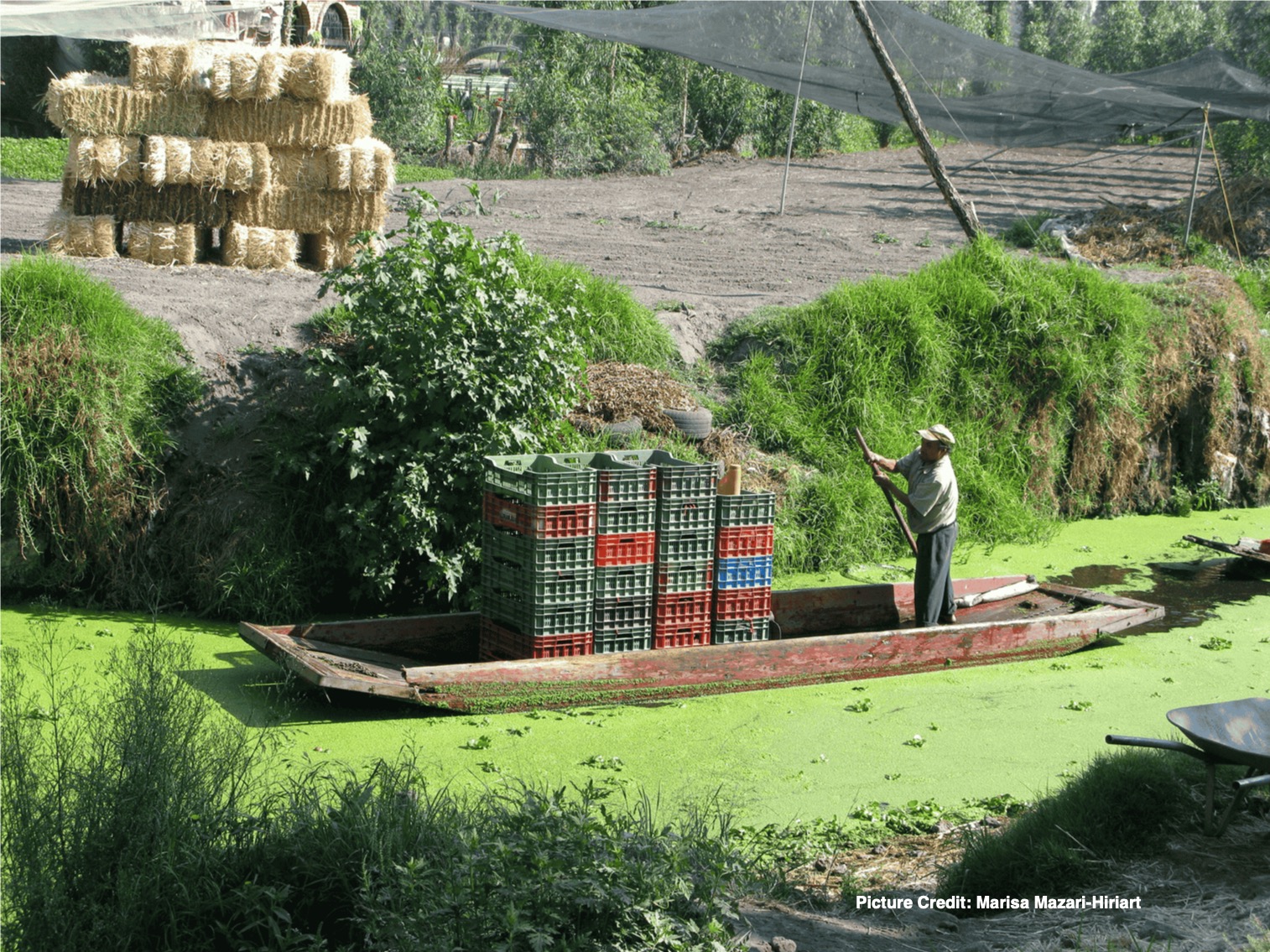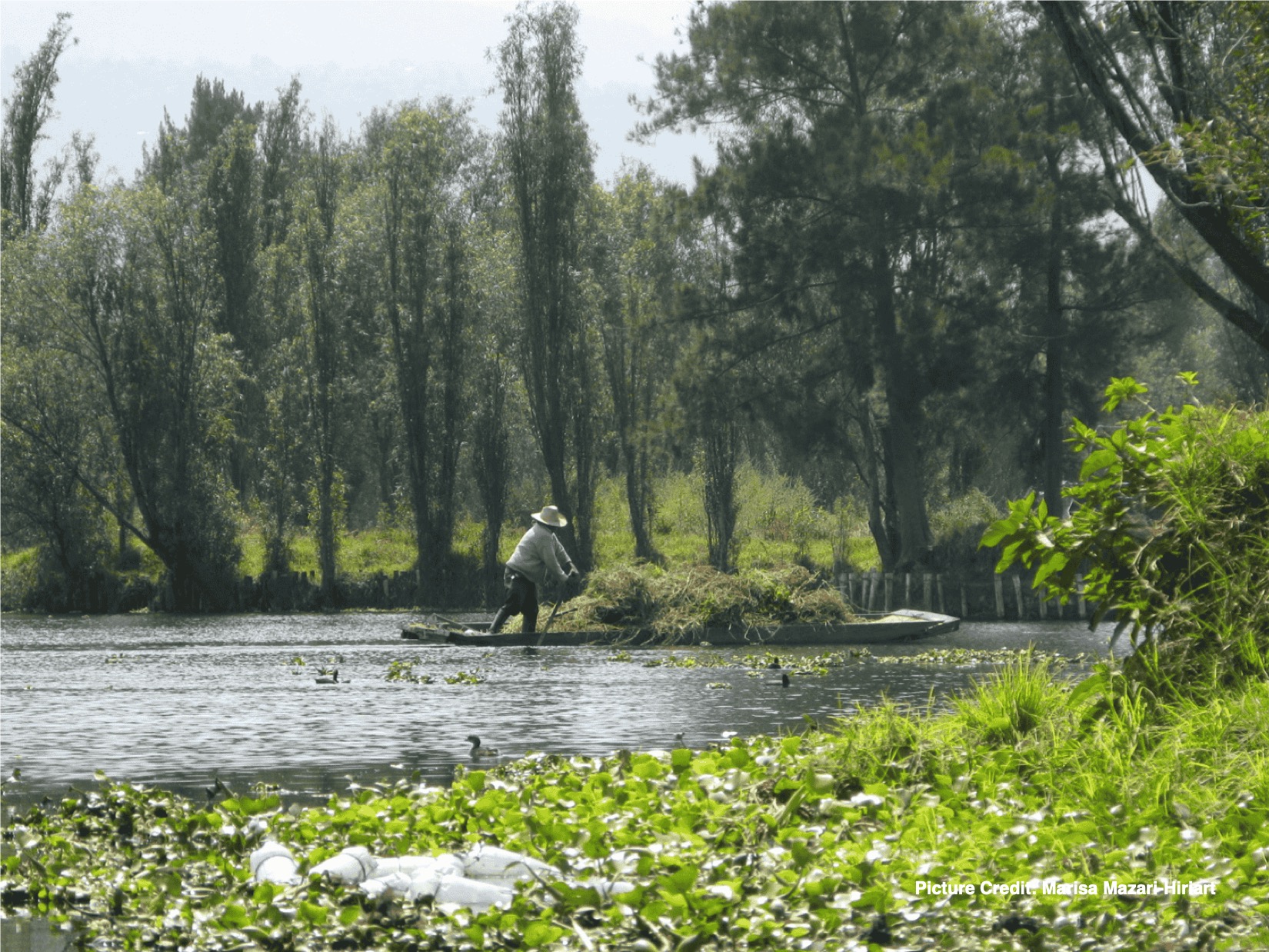From paper to practice: are public policies enabling transformative change? Reflections from the Xochimilco wetland







Like many water bodies around the world, the Xochimilco peri-urban wetland has faced serious threats and changes throughout decades, primarily driven by urbanization of the Mexico City region. Currently, the Xochimilco municipality has approximately 442,178 inhabitants (Gobierno de la Ciudad de México, 2024), and hosts a variety of different human activities ranging from ancestral practices such as agriculture, to modern ones like football fields. These activities take place daily within this magnificent and vital wetland ecosystem of bio-cultural importance.
To regulate these activities and to conserve the Xochimilco socio-ecosystem, numerous public policies have been created. For instance, the area holds national and local designations as a natural protected area and a conservation land area. Moreover, the wetland has been internationally recognized for both its environmental and cultural value, holding three international designations: it is a RAMSAR site, a FAO World Agricultural Heritage Site, and a UNESCO World Cultural Heritage. However, these instruments have not contributed significantly to implementing strategies toward more sustainable trajectories (SEPI, 2018).
Evaluating the Transformative Potential of Policies
As part of the Mexico Node work under the Water Transformation Pathways Planning project, an analysis of 44 Mexican public policies related to wetlands conservation was conducted. The analysis of these policy instruments followed the SPIRIT framework, an approach aimed at evaluating the transformative potential of water-related policies by identifying the presence or absence of certain characteristics that conform five key dimensions (Vij et al., 2017; 2021). To implement this analytical framework across the project, a group of project members developed additional criteria and designed the overall methodological strategy.
The five SPIRIT framework dimensions to examine a policy are:
- Scalability: A policy's capacity to be applied and produce effects across different territorial levels, from local to transnational, acknowledging that sustainability challenges require multi-level governance.
- Inclusivity with a power focus: A policy that enables participatory spaces for historically excluded groups, allowing vulnerable communities to engage in and influence decision-making and address structural inequalities often reproduced in policy formulation.
- Reflexivity: A policy that incorporates prior learnings and articulates with other policies and sectors, addressing both the causes and impacts of vulnerability through integrating multi-sectoral approaches for more comprehensive responses.
- Institutional flexibility: A policy aimed at ensuring institutions have regulatory and organizational mechanisms to adapt to changing contexts, new information, and unexpected conditions.
- Temporality: A policy's capacity to set clear objectives across different time frames and adapt to future uncertainties, recognizing the dynamic nature of change processes (Figure 1).
The predominant rationale behind the public policy design in Mexico adheres to a top-down, vertical paradigm. While techno-scientific expertise on specific issues is occasionally integrated, broader citizen participation remains notably limited. Our analysis reveals that most public policies demonstrate a consistent scalability, allowing their application across various territorial scales (Fonseca-Salazar, in preparation). These policies are typically specific, with primary regulations operating at the national level and subsequently adapted to local contexts. Furthermore, these incorporate elements of inclusion, at both nationally and local levels, emphasizing the imperative of integrating indigenous communities and women into decision-making processes. However, this inclusion is more often stipulated in policy documents than reflected in actual practice. Finally, the dimension of temporality is conspicuously underserved, characterized by an almost complete absence of robust evaluation mechanisms. Consequently, these policies tend to align with political cycles rather than to effectively address critical water sector issues or ensuring the long-term wetlands sustainability.
Additionally, mistrust among institutions —both academic and governmental —as well as local actors has hindered the effective use of available knowledge and marginalized the real needs of local populations, leading to persistent tensions.
Although Mexico has a long-standing history -spanning more than 100 years- in developing public policies related to environmental aspects in general, and to water resources specifically (Carabias, J., & Rabasa, A. 2017), substantive changes within the water sector have remained limited and thus insufficient (Núñez-Luna, 2009). Despite having policies aimed at conservation, ecological deterioration persists due to a lack of integrated management that involves local communities, the influence of economic interests such as tourism and urban development, weak enforcement of environmental regulations, and poor coordination among government entities.
From the policy analysis we identified 13 policy instruments that included restoration plans, management programs, water quality monitoring, axolotl conservation efforts, political appointments, local rescue plans, and both national and local laws (Fonseca-Salazar, in preparation). Together, these strategies represent millions of dollars invested in the area. For example, in 2020, the local government made an investment of $604 million MXN (33.93 million USD) - in rescuing environmentally valuable areas in Xochimilco. Of this, $222 million MXN ($12,48 million USD) was allocated to supporting the local farmers (chinamperos), and $182 million MXN ($10,22 million USD) was dedicated to the restoration of the Xochimilco Ecological Park (Comunicación Social, 2020).
The Path Forward
Although the Mexican government has incorporated water-related challenges into its agenda, there is still a lack of comprehensive strategies, effective programs, and robust evaluation mechanisms. Importantly, policy execution reveals pronounced territorial inequalities, and insufficient coordination mechanisms necessary to overcome governance fragmentation (Ortega, 2016; Barrios y Estrada, 2022). Another salient factor that hinders the capacity of policies to enable transformative change relates to the historical dominance of technocratic approaches that mainly promote infrastructure solutions in water policies, failing to address social-political and environmental dimensions in an integrated way.
Although watershed or river basin councils formally exist in the country, they are merely consultative bodies operating under a top-down model controlled by CONAGUA (the Water National Commission), excluding a broader participation of social sectors in decision-making processes. These types of structural obstacles are further exacerbated due to persistent corruption dynamics that perpetuate unequal water and resources allocation, hindering the possibilities for sustainable water management.
Lastly, and perhaps more significant than the aspects described above, is that the persistent political and institutional resistances to the adoption of these type of policies responds to a cultural clash between two opposed visions: one based on dominant western utilitarian approaches that separate people from nature and other beings (i.e., Integrated Water Resources Management -IWRM, Natural Protected Areas, Ecosystem Services, etc), and one centered in situated and unique ways of doing and being within the territory’s particular context and history (Convention on Wetlands, 2025). Thus, social local actors of Xochimilco are weary of recurring empty promises. However, hope for change continues to exist, as reflected in the daily activities of its inhabitants, the commitment of civil associations, and of researchers who continue to present evidence of the site's deterioration.
References
Carabias, J., & Rabasa, A. (2017). Cien años de políticas y normatividad ambiental. Universidad Nacional Autónoma de México, Instituto de Investigaciones Jurídicas, Instituto Belisario Domínguez. https://biblio.juridicas.unam.mx/bjv https://goo.gl/1xYmBr.
Convention on Wetlands (2025) Agriculture and Wetlands: Maintaining and restoring wetlands for sustainable food production and ecosystem health. Supplementary Materials: Case study descriptions. Gland, Switzerland: Secretariat of the Convention on Wetlands. DOI: 10.69556/strp.tr13.25.supp. https://www.ramsar.org/sites/default/files/2025-07/STRP_task3.3_supp.pdf
Comunicación Social (2020, 26 de julio). Inversión histórica para Xochimilco en materia ambiental. Alcaldía Xochimilco. http://www.xochimilco.cdmx.gob.mx/inversion-historica-para-xochimilco-en-materia-ambiental/
Fonseca-Salazar, M.A. (in preparation). Paper promises: are public policies making a difference?
García Barrios, J. R., & Mozka Estrada, S. (Eds.). (2022). Problemas del agua en México: ¿Cómo abordarlos? Fondo de Cultura Económica; Conacyt.
Gobierno de la Ciudad de México (2024). Xochimilco: Panorama geográfico y estadístico 2024. Instituto de Planeación Democrática y Prospectiva de la Ciudad de México.
Latargére, J., Méndez Bahena, A., & Alatorre Frenk, G. (2022). Obstáculos que impiden que los actores sociales existentes y sus redes de acción se constituyan en sujetos sociales capaces de remontar la crisis del agua. En: A. M. Chávez Aragón (Coord.), Problemas del agua en México: ¿Cómo abordarlos? (pp. 68–80) [Libro electrónico, 2023]. Consejo Nacional de Ciencia y Tecnología. https://secihti.mx/wp-content/uploads/publicaciones_conacyt/libros/Problemas_del_agua.pdf
Núñez Luna, A. (2009). Concepciones teóricas sobre la crisis de los recursos hídricos y su regulación. Isonomía, (31), 137-176.
Ortega, R. R. (2016). Prevención y resolución de conflictos en torno al agua ante la construcción de obras hídricas: Un caso de negación de agenda en México. Gestión y análisis de políticas públicas, 57-77.
Secretaría de Pueblos y Barrios Originarios y Comunidades Indígenas Residentes de la CDMX. (2018, 18 de junio). Recibe Sistema Agrícola Chinampero de CDMX certificado SIPAM de FAO. https://www.sepi.cdmx.gob.mx/comunicacion/nota/recibe-sistema-agricola-chinampero-de-cdmx-certificado-sipam-de-fao
Vij, S., Moors, E., Ahmad, B., Arfanuzzaman, M., Bhadwal, S., Biesbroek, R., ... & Wester, P. (2017). Climate adaptation approaches and key policy characteristics: Cases from South Asia. Environmental Science & Policy, 78, 58-65.
Authors & Contributors

María Alejandra Fonseca Salazar
Citation
